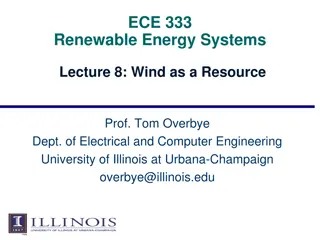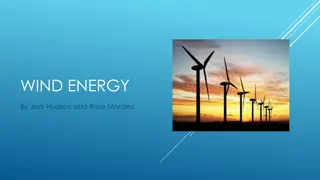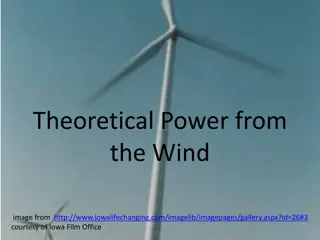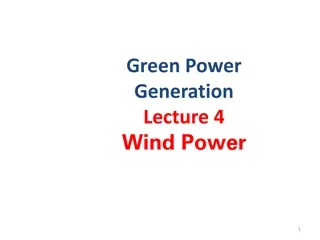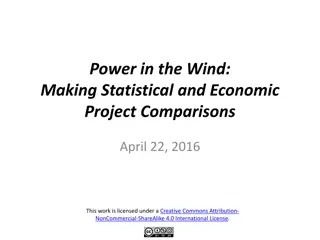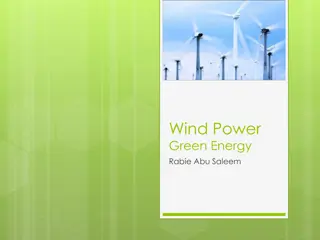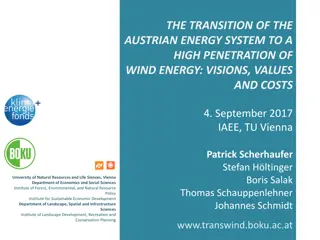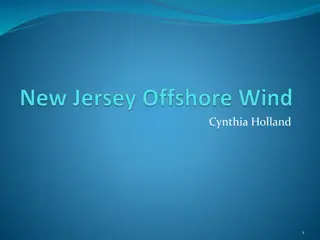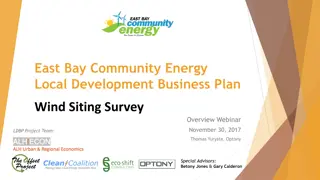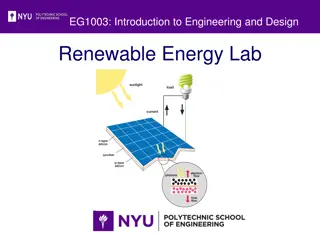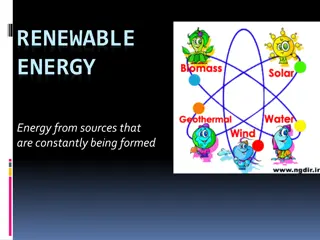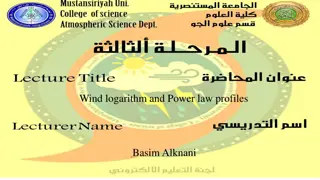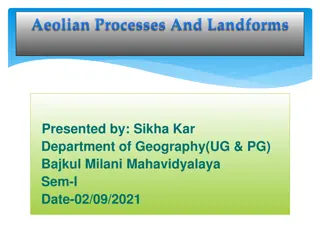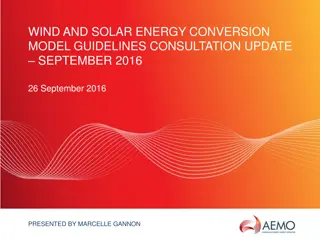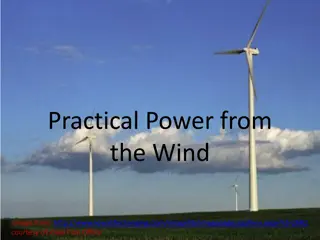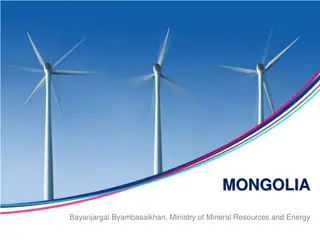Exploring the Evolution of Wind Energy
Wind energy has a rich history dating back to ancient times, with significant developments leading to modern turbines. The use of wind power has grown steadily, contributing to clean and renewable energy goals globally. It offers numerous environmental and economic benefits, such as reducing emissions and fostering energy independence. Top wind power-producing states highlight the increasing importance of this sustainable energy source in the U.S.
Download Presentation

Please find below an Image/Link to download the presentation.
The content on the website is provided AS IS for your information and personal use only. It may not be sold, licensed, or shared on other websites without obtaining consent from the author. Download presentation by click this link. If you encounter any issues during the download, it is possible that the publisher has removed the file from their server.
E N D
Presentation Transcript
PROJECT TITLE What Makes Wind
PROJECT TITLE Global Wind Patterns
PROJECT TITLE History of Wind Energy 5000 BC 5000 BC Sailboats used on the Nile indicate the power of wind 500 500- -900 AD 900 AD First windmills developed in Persia 1300 AD 1300 AD First horizontal- axis windmills in Europe 1850s 1850s Late 1880s Late 1880s Thomas O. Perry conducted 5,000 wind experiments; starts Aermotor Company Daniel Halladay and John Burnham build Halladay Windmill; start US Wind Engine Company 1888 1888 1941 1941 1979 1979 1985 1985 Early 1900s Early 1900s Windmills in CA pumped saltwater to evaporate ponds Charles F. Brush used windmill to generate in Cleveland, OH In VT, Grandpa s Knob turbine supplies power to town during WWII First wind turbine rated over 1 MW began operating CA wind capacity exceeded 1,000 MW 2016 2016 2004 2004 2013 2013 1993 1993 Block Island Offshore Wind Farm was brought online (US s first offshore wind farm) Electricity from wind generation costs 3 to 4.5 cents per kWh Wind power provided over 17% of renewable energy used in US US WindPower developed first commercial variable-speed wind turbine
Why Wind Energy? PROJECT TITLE Clean, zero emissions NOx, SO2, CO, CO2 Air quality, water quality Climate change Reduce fossil fuel dependence Energy independence Domestic energy national security Renewable No fuel-price volatility
PROJECT TITLE Renewable Electric Capacity Worldwide US DOE, EERE 2017 Renewable Energy Data Book
US Electricity Generation from Renewables PROJECT TITLE US DOE, EERE 2017 Renewable Energy Data Book
PROJECT TITLE Top Wind Power Producing States, 2017 Thousand MWh Thousand MWh Rank State Rank State 4,742 4,542 4,398 3,944 3,397 3,154 2,453 1 Texas 67,092 14 Indiana 2 Oklahoma 24,404 15 New Mexico 3 Iowa 20,816 16 Wyoming 4 Kansas 18,501 17 New York 5 California 13,971 18 Pennsylvania 6 Illinois 11,297 19 South Dakota 7 North Dakota 10,987 20 Idaho 8 Minnesota 10,885 21 Maine 2,222 9 Colorado 9,567 22 Montana 2,150 10 Washington 7,481 23 Missouri 1,949 11 Oregon 6,506 24 West Virginia 1,607 12 Nebraska 5,237 25 Ohio 1,563 13 Michigan 5,072
Annual Installed U.S. Wind Power Capacity PROJECT TITLE US DOE, EERE 2017 Renewable Energy Data Book
PROJECT TITLE Installed Wind Capacities 2018 1999 Total: 96,487 MW Total: 2,500 MW
PROJECT TITLE Wind Energy Potential by State
U.S. Wind Resource Map PROJECT TITLE
PROJECT TITLE Transmission Challenges
PROJECT TITLE China Leads the World in Wind Capacity Total Installed Generating Capacity (MW) Source: Global Wind Energy Council
Why Such Growth? costs are low! PROJECT TITLE Increased Turbine Size R&D Advances Manufacturing Improvements 1979 1979 2000 2000 6 cents/kWh 2004 2004 2017 2017 40 cents/kWh 40 cents/kWh 4 4- -6 cents/kWh 3 3- -4.5 cents/kWh 4.5 cents/kWh Less than 5 Less than 5 cents/kWh cents/kWh
Modern Wind Turbines PROJECT TITLE Turbines can be categorized into two classes based on the orientation of the rotor.
PROJECT TITLE Vertical-Axis Turbines Advantages Disadvantages Omni-directional accepts wind from any direction Rotors generally near ground where wind is poorer Centrifugal force stresses blades Components can be mounted at ground level ease of service lighter weight towers Poor self-starting capabilities Requires support at top of turbine rotor Requires entire rotor to be removed to replace bearings Can theoretically use less materials to capture the same amount of wind Overall poor performance and reliability
PROJECT TITLE Horizontal-Axis Wind Turbines Intermediate(10-250 kW) Village Power Hybrid Systems Distributed Power Small (<10 kW) Homes Farms Remote Applications (e.g., water pumping, Telecom sites, ice making) Large (250 kW-2+ MW) Central Station Wind Farms Distributed Power Schools
PROJECT TITLE Large Wind Turbines Common Utility-Scale Turbines 328 base to blade Each blade is 112 200 tons total Foundation 20 deep Rated at 1.5-2 megawatts Supply power to about 500 homes
PROJECT TITLE Wind Turbine Components
PROJECT TITLE How a Wind Turbine Operates
PROJECT TITLE Installation of Wind Turbines
PROJECT TITLE Wind Turbine Perspective Workers Blade 112 long Nacelle 56 tons Tower 3 sections
PROJECT TITLE Wind Farms
PROJECT TITLE Offshore Wind Farms The first U.S. offshore wind farm is Block Island Wind Farm, located off the coast of Rhode Island. This five-turbine, 30 megawatt wind farm began operation in 2016.
PROJECT TITLE Residential Wind Systems and Net Metering AC to Grid Wind Turbine AC Utility Meter AC Electrical Circuits AC Voltage Input DC Voltage Input Main Utility Breaker Panel Inverter & Interconnects
Potential Impacts and Issues PROJECT TITLE Property Values Noise Visual Impact Land Use Wildlife Impact Properly siting a wind turbine can mitigate many of these issues.
Impacts of Wind Power: Noise PROJECT TITLE
Wildlife Impacts PROJECT TITLE Top Common Human-caused Threats to Birds 3,000,000,000 2,400,000,000 2,500,000,000 Median/Avg. Estimated 2,000,000,000 1,500,000,000 1,000,000,000 599,000,000 500,000,000 214,500,000 25,500,000 6,600,000 234,012 0 Cats Building Glass Collision - Communication Towers Collision - Electrical Lines Collision - Vehicles Collision - Land- based Wind Turbines Hazard Type
For More Information PROJECT TITLE The NEED Project www.need.org info@need.org 1-800-875-5029 Energy Information Administration U.S. Department of Energy www.eia.gov



